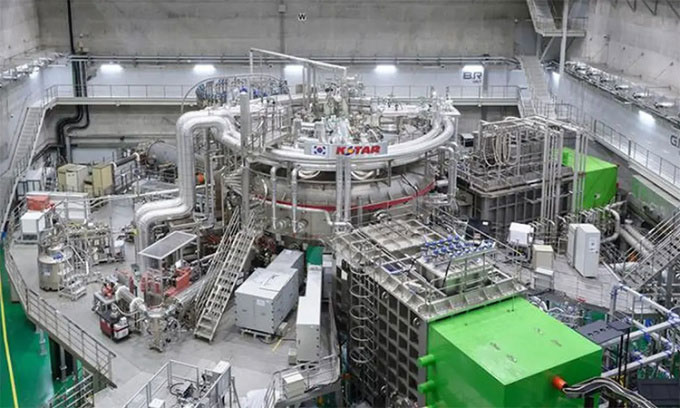Korea's fusion reactor is 7 times hotter than the Sun's core
Using a new tungsten diverter, the KSTAR fusion reactor successfully maintained a temperature of 100 million degrees Celsius for 48 seconds.
For the first time, the Korea Fusion Energy Institute's (KFE) Korean Tokamak Superconducting Advanced Research (KSTAR) fusion reactor reached a temperature of 100 million degrees Celsius. This achievement took place during testing from December 2023 to February 2024, marking a new record for the KSTAR project .

South Korea's KSTAR fusion reactor. (Photo: KFE).
KSTAR successfully maintained a temperature of 100 million degrees Celsius for 48 seconds. Meanwhile, the Sun's core temperature is 15 million degrees Celsius. In addition, the reactor also maintains high limit mode (H mode) for more than 100 seconds. H-mode is an advanced operating mode in magnetically confined fusion with a stable plasma state.
The fusion reaction simulates the production of light and heat from stars. This process involves fusing hydrogen nuclei and other light elements to release enormous energy. Experts hope to be able to use fusion reactors to create limitless carbon-free electricity.
According to the Korean National Science and Technology Research Council (NST), creating a technology that can maintain high temperatures and high-density plasma so that fusion reactions take place most efficiently over long periods of time is extremely important. The secret behind these great achievements is the tungsten diverter, NST said . This is a key component at the bottom of the vacuum tank in a magnetic fusion device, playing a key role in expelling exhaust gases and impurities from the reactor while still withstanding the large surface heat load.
The KSTAR team has switched to using tungsten instead of carbon in the diverter. Tungsten has the highest melting point of any metal. KSTAR successfully maintained H mode for a longer period of time largely thanks to this upgrade. "Compared to previous carbon diverters, the new tungsten diverter experiences only a 25% increase in surface temperature under similar heat loading. This provides significant benefits for high thermal energy operations long pulse" , NST explains.
The success of the tungsten diverter could provide valuable data for the International Thermal Experimental Reactor (ITER) project. ITER is a $21.5 billion international thermonuclear project being developed in France with the participation of dozens of countries, including South Korea, China, the US, EU countries and Russia. ITER is expected to create a plasma state for the first time in 2025 and begin operations in 2035. Tungsten will be used in the diverter of this reactor.
- The fusion reactor is 7 times hotter than the core of the Sun.
- China's $1 trillion 'artificial sun'
- China can successfully build the artificial Sun.
- The mystery behind the arc reactor in the Iron Man armor
- The fusion furnace has a magnetic field 100,000 times stronger
- US printed 3D nuclear reactor core
- Successfully built Stellarator-type thermonuclear reactor
- Ambition to harness energy from fusion reactions
- Pouring 1 billion yuan, China 'fired a laser' at the fusion empire of nearly 50 billion dollars
- Grid fusion synthesis power in 2050
- Why are China and many countries racing to make artificial sun?
- The supersonic aircraft is equipped with a fusion reactor
 Norway built the world's tallest wooden tower
Norway built the world's tallest wooden tower Kremlin
Kremlin Ashurbanipal: The oldest royal library in the world
Ashurbanipal: The oldest royal library in the world Decoding the thousand-year construction of Qin Shihuang shocked the world
Decoding the thousand-year construction of Qin Shihuang shocked the world